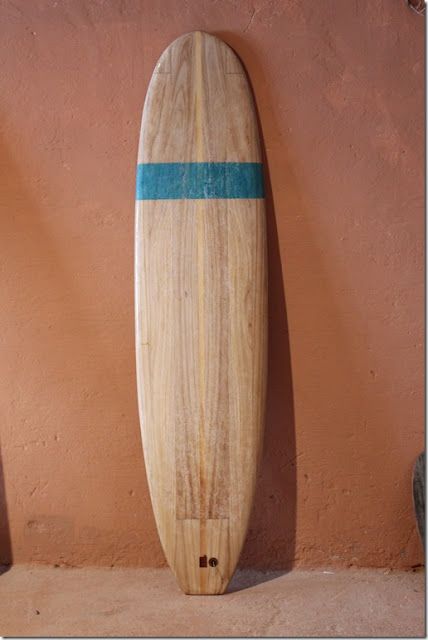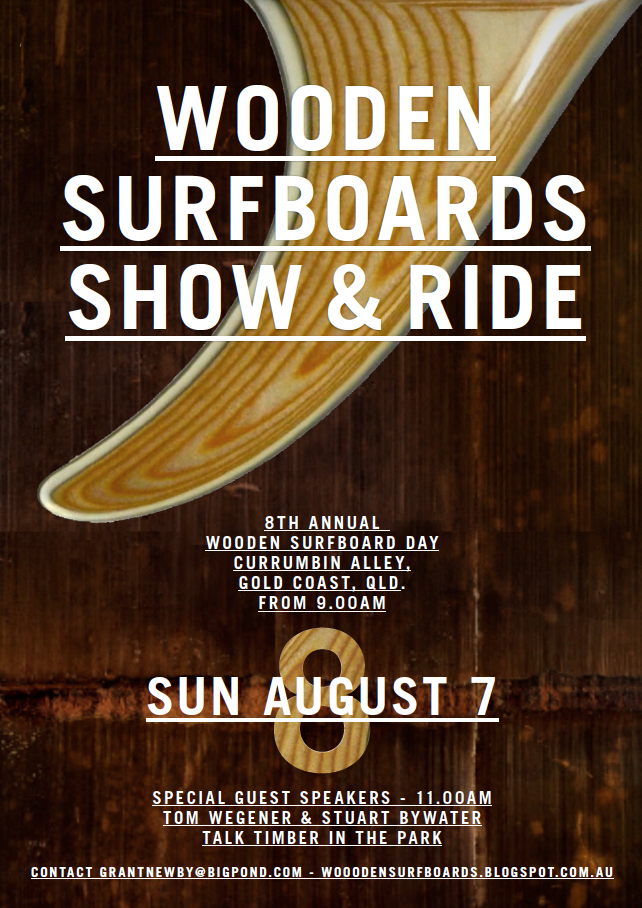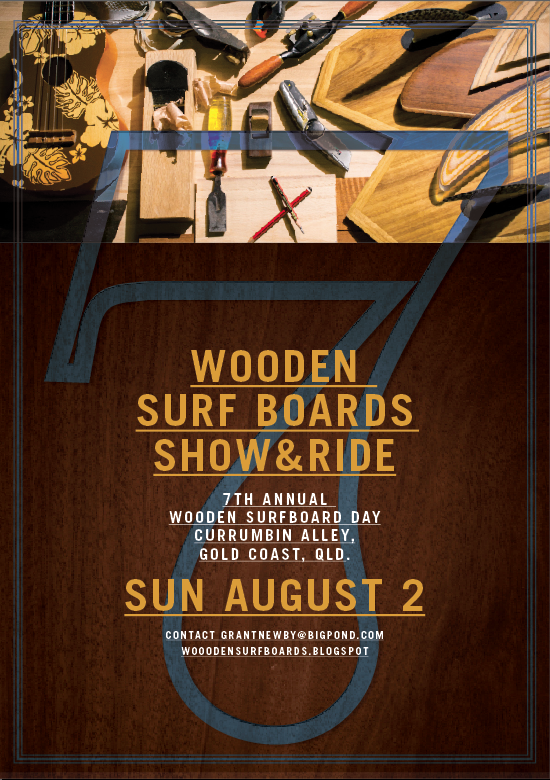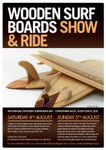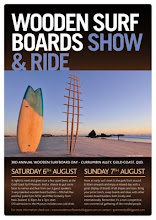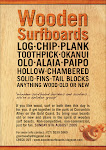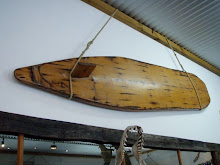Sunday, March 17, 2013
Tasmanian surfing history on display
"Using boards, clothing, contemporary accounts from newspapers and those
who were there making it happen, as well as some awesome photographs, HOME MADE - Surfing in Tasmania seeks
to understand Tasmania's contribution to surfing culture and also what
makes surfing the islands unique and special. As well as showing off
some beautiful surfboards!"
" Boards on display vary from a nine foot six inch long monster called 'The Gun', used by professional Tasmanian surfer Shaun Wallbank to surf Tasmania's biggest waves, to Margerie Thompson's board, made in 1925 from an old cedar table by E Harvie Thompson and used for bodyboarding at Clifton Beach for forty years until the 1960s.
The collection of boards shows the evolution of surfing. Small, home made boards from the 1920s were taken to beach parties and picnics and ridden prone, straight to shore. Tasmania's attraction for modern day surfers from around the world is shown through longboards used to surf some of the world's biggest waves.
Many early boards were homemade, in backyards or even near the beach itself, but the exhibition shows how commercial interests were quick to catch on to Tasmanian's enthusiasm for surfing with timber companies in Hobart and Launceston producing boards from the 1920s onwards.
Materials, too, have changed. the simple sheets of wood with, perhaps, a steamed nose and battens for stength of the early belly boards were replaced in the 1950s by the 'Okinui' style boards of shaped wood on which the surfer could stand, introducing the shapes and styles of boards and surfing we recognise today.
In the sixties and seventies the mood was for modern, man-made materials and the exhibition includes boards made from polystyrene and fibreglass form Tasmanian firms such as Turn, Tern, Fresh Juice, Milch, Osprey and Stranger. A return to traditional materials is shown by examples of hollow-framed timber boards made in the last few years and including traditional Tasmanian boat building timbers, such has King Billy pine and Celery Top pine.
As boards and the sstyle of surfing changed, so did the culture around it. The beach shack culture of picnics and days on the beach for families and groups of friends of both sexes for the relatively well off of the 1920s developed after the war with the emergence of the competitative, disciplined, exclusively male Surf Lifesaving clubs. By the sixties, surfing was appealing to a younger generation rebelling against the discipline and conformity of the post war years and these young surfers sought out new beaches and breaks, often driving for hours or trekking through the bush for miles in search of breaks that would be nicknamed - Fluffies, Horries Flobnobs, Rubbish Dump - to preserve the secrecy of their location."
" The exhibition includes examples of early beachwear; woollen swimsuits, football shirts and board shorts. Early wetsuits were also exclusively male, with the girls having to make do with ill-fitting wetsuits unaccustomed to their shape. We don't have an early wetsuit in the exhibition. But we'd love one, so if there is an old, mouldy, snagged or even torn, wetsuit hanging around in the back of your garage or shack, please do let us know!"
http://www.maritimetas.org/
" Boards on display vary from a nine foot six inch long monster called 'The Gun', used by professional Tasmanian surfer Shaun Wallbank to surf Tasmania's biggest waves, to Margerie Thompson's board, made in 1925 from an old cedar table by E Harvie Thompson and used for bodyboarding at Clifton Beach for forty years until the 1960s.
The collection of boards shows the evolution of surfing. Small, home made boards from the 1920s were taken to beach parties and picnics and ridden prone, straight to shore. Tasmania's attraction for modern day surfers from around the world is shown through longboards used to surf some of the world's biggest waves.
Many early boards were homemade, in backyards or even near the beach itself, but the exhibition shows how commercial interests were quick to catch on to Tasmanian's enthusiasm for surfing with timber companies in Hobart and Launceston producing boards from the 1920s onwards.
Materials, too, have changed. the simple sheets of wood with, perhaps, a steamed nose and battens for stength of the early belly boards were replaced in the 1950s by the 'Okinui' style boards of shaped wood on which the surfer could stand, introducing the shapes and styles of boards and surfing we recognise today.
In the sixties and seventies the mood was for modern, man-made materials and the exhibition includes boards made from polystyrene and fibreglass form Tasmanian firms such as Turn, Tern, Fresh Juice, Milch, Osprey and Stranger. A return to traditional materials is shown by examples of hollow-framed timber boards made in the last few years and including traditional Tasmanian boat building timbers, such has King Billy pine and Celery Top pine.
As boards and the sstyle of surfing changed, so did the culture around it. The beach shack culture of picnics and days on the beach for families and groups of friends of both sexes for the relatively well off of the 1920s developed after the war with the emergence of the competitative, disciplined, exclusively male Surf Lifesaving clubs. By the sixties, surfing was appealing to a younger generation rebelling against the discipline and conformity of the post war years and these young surfers sought out new beaches and breaks, often driving for hours or trekking through the bush for miles in search of breaks that would be nicknamed - Fluffies, Horries Flobnobs, Rubbish Dump - to preserve the secrecy of their location."
" The exhibition includes examples of early beachwear; woollen swimsuits, football shirts and board shorts. Early wetsuits were also exclusively male, with the girls having to make do with ill-fitting wetsuits unaccustomed to their shape. We don't have an early wetsuit in the exhibition. But we'd love one, so if there is an old, mouldy, snagged or even torn, wetsuit hanging around in the back of your garage or shack, please do let us know!"
http://www.maritimetas.org/
Thursday, March 14, 2013
Dugout Surfcraft from BC
Darren Mac Donald from BC Canada has come up with a very different approach to his wooden boards. As you can see they are carved out of solid wood , yet able to flex where they need to. A great level of skill and craftsmanship.
"Carved in the tradition of wooden watercraft that form the roots of surfing (think canoes and plank boards), Dugout shapes are at play with the nature of the wood that forms them. Dug out – hand shaped and amply chambered (selectively hollowed), cedar's aesthetic and resonant qualities are free to flow through on a wave. Cedar (salvaged Western red and Alaskan yellow cypress) is light, highly resistant to moisture and stands up well in marine environs. Dugouts are sealed with a natural wax and oil blend that provides a slick durable finish without affecting the wood's flexibility or feel."
"The Dugout pictured is shaped in alaia style, with zero rocker until engaged in the water. Ridden finless or twin, its volume at the chest makes for easier paddling and the thickness of its tail catches waves, where the thin step rails hold it..."
"Carved in the tradition of wooden watercraft that form the roots of surfing (think canoes and plank boards), Dugout shapes are at play with the nature of the wood that forms them. Dug out – hand shaped and amply chambered (selectively hollowed), cedar's aesthetic and resonant qualities are free to flow through on a wave. Cedar (salvaged Western red and Alaskan yellow cypress) is light, highly resistant to moisture and stands up well in marine environs. Dugouts are sealed with a natural wax and oil blend that provides a slick durable finish without affecting the wood's flexibility or feel."
"The Dugout pictured is shaped in alaia style, with zero rocker until engaged in the water. Ridden finless or twin, its volume at the chest makes for easier paddling and the thickness of its tail catches waves, where the thin step rails hold it..."
Wednesday, March 13, 2013
The 5ft 8" simmons for charity
Dan Johnston from Blind Dog Surfboards has been building a special board. "This board, 5'8" Mini-Simmons, will be raffled off in May to help support a family who's was father to two great kids, wonderful husband, and great friend to all surfers (groms to pros) who had the wonderful opportunity to meet Chris. He died at 37 on November 2011. This is the second annual surf-off that last year raised over $4,000. Our board raffle contributed $780. This year we hope to double that for this board."
"All Western (US) Cedar, custom made fins, 4 oz glass top and bottom with epoxy. Built with concave running from 1/3 front to rear. "
www.BlindDogSurfboards.blogspot.com
"All Western (US) Cedar, custom made fins, 4 oz glass top and bottom with epoxy. Built with concave running from 1/3 front to rear. "
A great looking board with special meaning.
www.BlindDogSurfboards.blogspot.com
Tuesday, March 12, 2013
Wooden board classes in the UK and Europe this year.
Paul Reisberg builds wooden beautiful boards and holds classes in the UK and Europe. He has just sent me details of his upcoming plans for the year.
"I can also announce the next UK date for such a three day board building jam. the weekend 26/27/28 April 2013. I have space for 4 builders at the Bridge Boathouses in Richmond / London / UK.
There is more information on arbosurfboards.blogspot.com and people interested should get in touch via email: paulitspaul@gmx.net"
"I will be based at the Underfall yard in Bristol for the year and like last year in the Basque Country, I open up my workshop to people who want to learn how to build hollow wooden surfboards with the strip-and-feather method. Apart from the intense three day workshops with four participants I can offer one-on-one weekends and evenings. dates can be arranged individually."
"For past participants who still haven't glassed their boards I will organise a glassing/laminating weekend where I will show my way of glassing hollow wooden surfboards with entropy resin. When exactly I would arrange with those interested. Everyone who still fears the task of glassing a board can contact me so we can start settling on a date."
"Anyone who wants a hollow wooden surfboard in paulownia but is not interested in the process and only the final product can order a custom board with me. I will build one board per month this year. "
Paul has some great designs that he has come up with and offers a wide range of boards which is great to see. The finished boards look like some of the best out there.
A happy crew who will remember their time together for the rest of their lives. These won't be their last boards either I can bet.So if you can take the time and are able to I would suggest you are in the best of hands with Paul teaching you he ropes and you will end up with a board you can be very proud of.
"I can also announce the next UK date for such a three day board building jam. the weekend 26/27/28 April 2013. I have space for 4 builders at the Bridge Boathouses in Richmond / London / UK.
There is more information on arbosurfboards.blogspot.com and people interested should get in touch via email: paulitspaul@gmx.net"
"I will be based at the Underfall yard in Bristol for the year and like last year in the Basque Country, I open up my workshop to people who want to learn how to build hollow wooden surfboards with the strip-and-feather method. Apart from the intense three day workshops with four participants I can offer one-on-one weekends and evenings. dates can be arranged individually."
"For past participants who still haven't glassed their boards I will organise a glassing/laminating weekend where I will show my way of glassing hollow wooden surfboards with entropy resin. When exactly I would arrange with those interested. Everyone who still fears the task of glassing a board can contact me so we can start settling on a date."
"Anyone who wants a hollow wooden surfboard in paulownia but is not interested in the process and only the final product can order a custom board with me. I will build one board per month this year. "
Paul has some great designs that he has come up with and offers a wide range of boards which is great to see. The finished boards look like some of the best out there.
A happy crew who will remember their time together for the rest of their lives. These won't be their last boards either I can bet.So if you can take the time and are able to I would suggest you are in the best of hands with Paul teaching you he ropes and you will end up with a board you can be very proud of.
Monday, March 11, 2013
Beautiful Peter Walker board
The is a new hollow 7'6" Paulownia board built by Peter Walker with Stephen Bowers artwork. Currently on exhibition at the Museum of Fine Art Boston, USA from Feb 20 to July 14 2013 as part of the "New Blue and White" exhibition. Beautiful board and great talent.
Sunday, March 10, 2013
Vinnies latest board in Ireland
Vinnies new board is - 6' 08" x 18 .5" x 2.5"
rails - standard shortboard , rocker - standard shortboard
single into double concave
bottom shape - pretty much flat with some slight vee

rails - standard shortboard , rocker - standard shortboard
single into double concave
bottom shape - pretty much flat with some slight vee
"Leyland Cypress deck and bottom skin
reclaimed Cedar - rails and internal structure Iroko - nose strengthers ( four small pieces of wood left overs )
fins - unknown hardwood from skip
leashplug - that yellow wood again Berberis I think
brass - air vent "
"Standard wood glue and it's finished with many layers of water based varnish inside and out - low voc's"reclaimed Cedar - rails and internal structure Iroko - nose strengthers ( four small pieces of wood left overs )
fins - unknown hardwood from skip
leashplug - that yellow wood again Berberis I think
brass - air vent "
" This board is by and large petrochemical free , a small bit of epoxy was used and rovings where the fins join the board . the fins are glued into the structure of the board so are strongly connected to the board yet they have flex themselves . I went for the quad setup because I love surfing this fin setup . Also a small bit of flexible tec7 type stuff is used to join the brass valve to the wooden skin ."
" The Leyland Cypress was grown here where I live , I had a chunk of it put by and it dried out and I thought Id see could I get some timber out of it . "" It turned out well , its a really strong wood yet light when fully dried , and easy enough to work with . It takes a bend along the grain easy but a bit fussier being bent across the grain .
So this board is super strong , it wont ever snap in my opinion , strong enough not to need glass and cloth . This is a true eco board yet because it is varnished its not going to take as much abuse as a harder fiberglass would in terms of scratching . A bit of care is needed in loading unloading , avoiding rocks when paddling out , etc etc "
The beauty of the varnish though is that it can be sanded back and given a couple of coats every few years . If cared for these boards will last a long time .
I wont go on about the air volume here as I have ranted on about it already in the past - suffice to say these boards are really good to surf , this board in particular feels really sweet and nicely balanced weight wise to me . If I was going somewhere like Indo this would be the board I'd bring with me ."
Check out what else has been up to at : ohalloranboards.blogspot.ie
Rrecreating history in Brasil
" My name is Guilherme Pallerosi, and I´m from Brazil. I have a blog about the wooden boards and surf history, and I’ve show a hollow board here, almost a year ago. So, I’ve made by my self a new alaia board, trying to follow the 30’s projects. It’s not exactly the same, but the shape and processes is similar or inspirited on!
" To end the board, we put a Costa Rica coin to fix the lashing. The coin photo is not good, but its very style! We made some kind of launch before to put the board in the sea. The surf was little hard in the beginning, but its work very good at north of São Paulo coast."
" To make the board softer we hollow the central plank (and to compensate the extra resin weight). The complex whole were put together with epoxy glue and dowels. The board is 6’6 ft tall, not big as the old 30’s, but a hybrid of a modern alaia."
" I have a help of a specialist friend, the slow-woods-worker Murilo Marcondes. We decided to use two Brazilian woods: the caixeta, and the fabulous red cedar (or pink cedar as we use to call). Both woods are soft, but caixeta is not good for water uses, so we have to glass it with epoxy resin."
" To end the board, we put a Costa Rica coin to fix the lashing. The coin photo is not good, but its very style! We made some kind of launch before to put the board in the sea. The surf was little hard in the beginning, but its work very good at north of São Paulo coast."
" To make the board softer we hollow the central plank (and to compensate the extra resin weight). The complex whole were put together with epoxy glue and dowels. The board is 6’6 ft tall, not big as the old 30’s, but a hybrid of a modern alaia."
" I have a help of a specialist friend, the slow-woods-worker Murilo Marcondes. We decided to use two Brazilian woods: the caixeta, and the fabulous red cedar (or pink cedar as we use to call). Both woods are soft, but caixeta is not good for water uses, so we have to glass it with epoxy resin."
The plans and inspiration
To watch the processes you can access my blog link (its Portuguese write): http://madeiraeagua.blogspot.com.br/2013/02/construindo-moderna-alaia-1930.htmlTuesday, March 5, 2013
The wooden nugget
This is Torten Koflers current project, a 7’6” x 22 1/2” x 3 1/4” big guy nugget. HWS method with solid rails. Designed on AKU Shaper using Hollow Board Template Maker for the templates.
6mm paulownia for ribs, stringer, deck and hull. 5mm paulownia for rail bands. 4mm paulownia for the inner rail band as it’s easy to steam and bend.
The steam iron at work.
Stringer and ribs are laminated with 4oz glass and epoxy resin for extra strength and to avoid splitting.
Taking shape and looking good.
Frame complete and ready for skins
"Next step is the deck and hull skins. Feeling a bit more experienced since I destroyed my first board with the vacuum bag. Learning heaps particularly the upper limits of my character."
Building a wooden board is a great learning experience for anyone. Very character building for most of us .
Subscribe to:
Posts (Atom)










.jpg)
.jpg)
-1.jpg)
.jpg)
-1.jpg)
-1.jpg)
-2.jpg)
-1.jpg)


